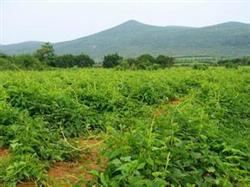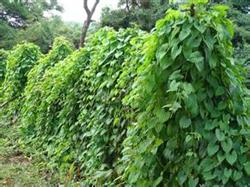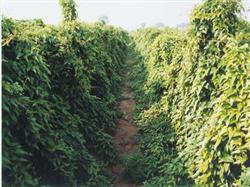Standardized production technology of yam

First, the environmental conditions of yam planting have relatively strict requirements on the soil. generally, the soil layer is deep and loose, and the loam or sandy loam is planted in the soil layer 1 meter below the surface, which does not contain tree roots, stones or rubble. Clayey land can also be planted, but it will reduce the commercial nature of yam and is not easy to harvest. Second, cultivation techniques 1. Open ditches and straighten the bed. Planting Chinese yam can be ditched manually or mechanically. (1) artificial trenching. Manually dug in winter leisure, according to the ditch distance of 1.4 meters, ditch width of 35 cm, ditch depth of 1 m, dug out of raw and mature soil were placed respectively. Dig ditches before winter, when overwintering, some underground pests can be frozen to death. In the early spring of next year, with thawing and filling into the ditch with the filling, first fill the raw soil and then fill the cooked soil, do not disturb the soil layer when filling the cooked soil, 1x15 ha (1 mu) is mixed with fully mature organic fertilizer 4000 kg, potassium sulfate compound fertilizer 50 kg, fully mixed with the soil and then filled into the ditch, when 90% is filled, water is firm, bottom water is filled, and then ridges are filled to prepare for planting. (2) mechanical trenching. Before ditching, 5000 kg of organic fertilizer and 50 kg of potassium sulfate compound fertilizer were applied to 15 ha before ditching, leveling and raking fine, mechanical trenching according to 85 cm row spacing, and the soil dug out after ditching was ridged and stepped on, and the soil was cultivated into a ridge for sowing. 2. Cultivate strong buds. The yam seedlings weighing 50 ~ 75 grams, no rot and dryness, healthy and full and with mouth buds were selected and dried for about 10 days at the end of March and the beginning of April to dry and crack the cross section. When the buds grow to 0.5cm long, select the blunt round and sturdy seedlings, use the mixture of 1000 times of 25% trimethoprim, 50 times of carbendazim and 200 times of Jinggangmycin, soak the seeds for 5 minutes, fish out and dry, and then sow seeds. 3. Sowing time. Choose sunny weather to sow in early April, no later than the middle of April at the latest. 4. Planting density and method. The main results are as follows: (1) artificial trenching is made in the middle of the ridge with two small trenches 10 cm deep (that is, double-row planting), with a distance of 15 cm apart, and the planting is placed horizontally in the middle of the ditch. The plant distance (refers to the distance between the two seed buds) is 10 cm 20 cm, and 5000 plants are planted every 15 hectares. (2) mechanical trenching. Open a small trench 10 cm deep in the middle of the ridge (that is, planting in a single row), and place the plants in the ditch in the same way, with a spacing of 15cm to 17cm, planting 500O plants for every 15 hectares. No matter which method is adopted, seed fertilizer and pesticide should be applied in the ditch before planting. Generally, the seed fertilizer is 4kg of available nitrogen fertilizer and 4kg of potash fertilizer per hectare. In order to prevent underground pests, the fried bean cake can be watered with phoxim EC, wet and sprinkled into the ditch, and the fertilizer and medicine will be mixed with the soil before sowing, and whether to irrigate the ditch is determined according to the soil moisture before planting. Mechanically trench both sides of the ridge to prevent water seepage and collapse. Third, field management 1. Bracket. A few days after the emergence of Chinese yam, the bracket should be in the shape of a "human" frame, with a height of more than 1.5 meters, horizontally drawing iron wire and fixed with wooden stakes to prevent the bamboo frame from being blown down by strong winds. 2. Water and fertilizer management. After planting, high-quality soil fertilizer can be applied in front of the support, and organic fertilizer can be applied in the growing stage and the peak period of rhizome growth. From the middle of June, potassium sulfate compound fertilizer was applied, 20 kg per 15 ha, once every 15 days, a total of 3 times and 4 times of external topdressing. 0.3% urea, 0.3% potassium dihydrogen phosphate or spraying with Yemanbao and plant power 2003 can be used to prevent premature senility. If the seedlings are too strong, use zhuangsu to spray seedlings. 3. Pest control. The main diseases of Chinese yam are brown spot and anthracnose. In summer, attention should be paid to preventing waterlogging and dehumidification, enhancing ventilation and reducing the occurrence of diseases and insect pests. The disease can be sprayed 2 times with 70% methyl topiramate 500 times or 77%. The main insect pests are yam leaf wasps, which can be controlled with 2.5% enemy killing 2000 times solution. Fourth, harvest and storage yam gradually withered in the middle and late October, and the yam can be harvested according to the market situation. The harvest period of yam is very long, and it can be collected and sold at any time from maturity to March of the next year. If the market price is low, it can be saved in the planting ditch. It can also be used for cellar storage or indoor storage after planing, as long as it is not damaged by low temperature. The method is to select the yam without decay, mechanical damage and up to the standard, wrap it with clay immediately after planing, and discharge it layer by layer in the thermal insulation and sterilized cellar or indoors. This simple storage method can preserve the yam for more than 3 months.
- Prev

How to prevent diseases and insect pests of Chinese yam
First, anthrax. Chinese yam is easy to produce anthracnose in high temperature and rainy season, resulting in withered stems and fallen leaves. In the early stage, there were black spots on the leaves, but in the later stage, the color of the leaves changed to black, and the disease spots were flooded, which seriously affected the plant growth and reduced the yield. Prevention and treatment: spray 50% acetaminophen 600 times every 7 days, or 7.
- Next

Key points of cultivation techniques of Yam (Dioscorea zingiberensis)
Variety selection at present, the main varieties of yam are fine-haired yam, Ermao yam and Japanese "Daiwa taro" yam. Both fine-haired yam and Ermao yam belong to the variety of common yam. Japanese yam is a variety with strong adaptability, good quality, strong disease resistance, high yield and promising development. ...
Related
- Where is it suitable to grow horseradish in China? it is expected to see the middle altitude horseradish in Alishan.
- How to prevent tomato virus disease reasonably? (Control methods included)
- Many people like to plant towel gourd on the balcony. What are the main points of this method and management?
- What crops can chili peppers be mixed with?
- Fertilization techniques and matters needing attention in Tomato
- What are the grafting techniques for peach seedlings in spring?
- Harm and control methods of root swelling disease of Chinese cabbage
- What are the pests of sweet potatoes? How to prevent and cure it?
- Symptoms, causes and Control methods of navel Rot in Tomato
- The cause of "Cucumber rotten bibcock" in Farmers' planting Cucumber and its Control Plan

